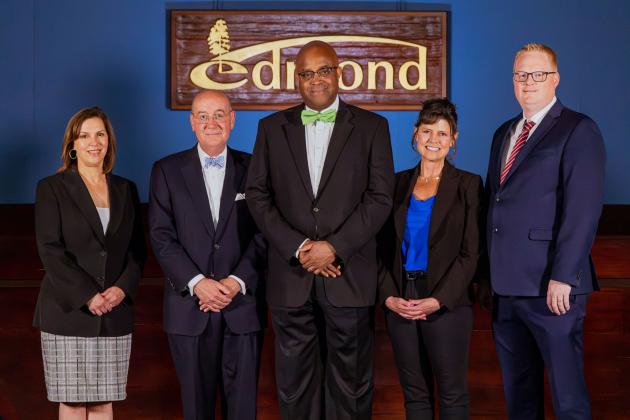Edmond City Council approves agreement for downtown streetscape standard strategy project.
The Edmond City Council Monday night approved a Professional Services Agreement with Kimley Horn for the Downtown Streetscape Standard Strategy Project.
The project cost is $153,700 and will be paid through part of the City’s ARPA funds.
Ryan Ochsner, Director, Community Image, told the Council that the City’s current streetscape design concept has very little detail and does not identify where different styles of streetscape should be used. The current concept does not provide well-coordinated development of streetscape for the downtown area. This project will develop typical streetscape standards and identify the streetscape arrangements that various streets should receive.
The scope of this service includes evaluation and planning to guide streetscape development in the downtown area.
Ochsner said generally, streetscape refers to the public space along private developments. Well-designed streetscape will maximize access and use of this public space. In the urban area these spaces commonly include safe, comfortable space for multiple forms of travel. Additionally, high functioning streetscapes will provide space for resting, relaxing, dining, and socializing while experiencing the surrounding neighborhood. Streetscapes commonly include trees, landscape, parking, furnishings, art, lighting, and other amenities that complement adjacent property uses.
This project will include evaluation of Edmond’s downtown with a focus on public involvement, streetscape, mobility and safety, green space opportunities, and parking. The area to be planned for is generally bounded by North University Drive (east), E. 5th Street (south), Fretz Ave. (west), and W West Thatcher Street (north).
“The streetscape, and when we talk about that, we're talking about everything from the roadway where cars travel to where cars park, to where pedestrians traverse into all those activities that we would like and hope to see in our public spaces in the downtown area,” Ochsner said.
For the project, a stakeholder committee will be established to serve as a review, input, and advisory body. It’s anticipated that the consultant will have three meetings with this group.
Ochsner said this group will help establish the goals, priorities, and vision for the streetscape standards. This group will also identify a preferred vision, and evaluate suggested streetscape elements. The process will also include a public meeting to review a draft version of the streetscape strategy.
The consultant will become familiar with the documents and plans that can serve as reference throughout the project. They will also inventory existing conditions throughout the area, documenting existing vegetation, furnishings, building uses, streetscape elements, and natural, cultural, architectural, and historic precedents.
The consultant will prepare an inventory map of existing roadways, on- and off-street parking facilities, sidewalks, bicycle infrastructure, zoning, existing and future land use, trails, and existing transit/bus stops.
They will also review the 2020 Downtown Parking Study to understand the existing supply/demand relationship in the area. Data will be used to identify existing parking constraints, opportunities, behavior trends, and obstacles, geared towards predicting future conditions and framing the understanding of the current parking system and its adaptability to change.
Ochsner said the consultant will develop alternative vision, goals, and themes for the Downtown Streetscape Standards and present it to the Stakeholder Committee. From these the committee and consultant will work to develop a preferred vision statement to guide the design of components within the Downtown Streetscape Standards Master Plan.
He said the consultant will prepare a plan that indicates the hierarchy of streetscape types, general planting schemes, general concepts for hardscape treatments and general locations for new street and pedestrian light standards and bollards. Building on stakeholder preferences the consultant will identify proposed streetscape elements, and prototypical plans to illustrate the design intent for a range of streetscape types.
The consultant will plan to present the information to the Urban Board and/or Planning Commission and City Council for review.
“I'm anticipating completion within six to eight months and we're going to use our stakeholder group and our public boards as this is developed to go through and capture as much of that as we can,” Ochsner said.
In other matters, Kory Atcuson, City Clerk, gave a presentation on discussion and Direction to City Staff Regarding City Council and Public Works Authority Meeting Rules.
On Oct. 9, members of the City Council participated in a workshop to discuss possible rules for City Council / Public Works Authority meetings.
“At that workshop we discussed the possibility of adopting rules for City Council and Public Works Authority meetings, just like the meeting we're in this evening,” Atcuson said. “In that conversation, the feedback that we heard was that it would be appropriate to establish rules that are in line with our values of transparency, accessibility, efficiency and effectiveness, but also balancing that with making sure that items are clear.”
Councilmembers also indicated that rules should be clear, concise, and consistent, so that everyone could understand expectations for meetings.
Atcuson laid out preliminary proposals for the Council to review.
First, staff would propose to move Public Works Authority Consent and Discussion Items before City Council Consent and Discussion Items.
Second, staff would propose that we provide written guidance on what items do and do not go into General Consent. An example of how this could be accomplished would be adding the following language:
Agenda items should be place in City Council or Public Works Authority general consent unless:
- A public hearing is required by law, agreement, or other City of Edmond policy;
- A councilmember has indicated that they would like to discuss the item;
- A councilmember has indicated that they have a conflict of interest;
- Conflicting recommendations from staff and/or boards and commissions exist;
- The item is a purchase or approval of contract involving over a certain amount of money.
- The item is a change order or contract amendment where the total cost is over a certain amount of money.
- The item is a supplemental or transfer of appropriation involving over a certain amount of money.
- A presentation is necessary to explain the agenda item;
- A discussion is necessary to provide direction on the agenda item;
- The item is otherwise not appropriate to be considered under general consent.
“One thing I want to note here is that the rules that are drafted are, we can change everything,” Actuson said. “It's nothing that's set-in-stone at this point. It is entirely a draft and these are your rules. We really want to incorporate any feedback and perspectives you have when you're having this conversation.”
No action was taken on the proposals, but the Council indicated it would like to discuss the matter at a workshop in January.
The Council also approved creation of the Development Impact Fee Focus Group; Establishing its Duties and Responsibilities; Providing for the Appointment and Qualifications of Members; Providing for Meeting Rules; and Providing for Dissolution.
Ken Bryan, Long Range Planner, Planning/Zoning, said two recently approved studies found significant gaps in the City’s ability to continue to provide services.
Both the East Edmond 2050 Plan and the Revenue and Expense Optimization Study recommended a series of fiscal studies to evaluate approaches to diversifying the City’s revenue program specifically related to the cost associated with new development.
Edmond has contracted with TischlerBise, Inc. to study and calculate “Development Impact Fees.” The proposed resolution would create a Development Impact Fee Focus Group to provide feedback to the consultant.
The Focus Group would consist of 19 total members, with two representatives from the Edmond Planning Commission; two representatives from the Parks and Recreation Advisory Board; two representatives from the Capital Improvement Project Advisory Board; two representatives from the Central Edmond Urban District Board; seven development sector professionals, such as engineers, land use attorneys, real estate professionals, and builders; as well as four members of the public at-large.
The Development Impact Fee Focus Group would begin meeting in December and would dissolve once the study is complete or Dec. 31, 2024, whichever is earlier.
“Their first meeting is scheduled for next Monday, Dec. 4 at 5 p.m. at the Edmond Conference Center,” Bryan said. “Following the focus group meeting, there will be a public open house so people can learn about development impact fees, ask questions. We should see draft deliverables for this study later this spring. But the final study ordinance and administrative items will be delivered to us in the summer.”



